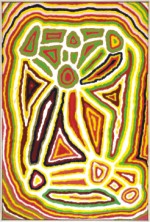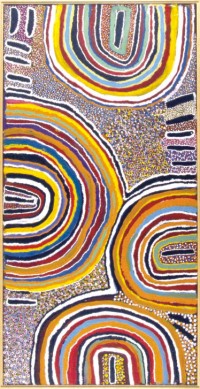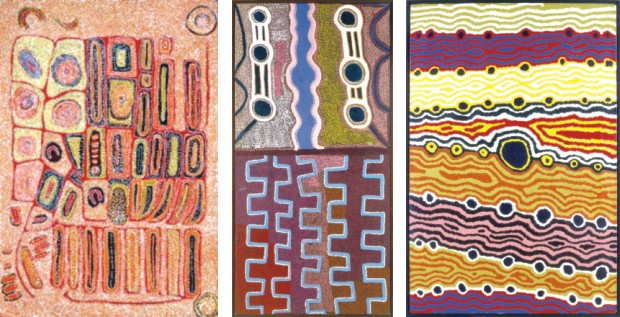| Home - Back Issues - The Team - Contact Us |
 |
| Volume 10 |Issue 14 | April 08, 2011 | |
|
|
Exhibition Art from the Balgo Hills Jennifer Ashraf Kashmi
When asked to share his feelings on the exhibition Deputy High Commissioner Tim Bolotnikoff answered, “We are proud to share our culture and heritage in Dhaka. It brings me immense pride to see the artistic work of our indigenous people getting such international recognition”. So, are the pictures a genuine artistic depiction of Australia? “I believe there are two ways to look at it -- the individual perspective and the perspective of the people as a whole,” he said. “The land is very important for our Aboriginal people; it's about how the people as a whole look at the land through their eyes. Thus, at the end of the day, these pictures reflect the view of the Australian people as a whole.” The aim of the exhibition was to mainly promote a deeper understanding and awareness of Australia's rich and vibrant indigenous cultures. Since being initially launched in Canberra, Australia in December 2008, BALGO has travelled to more than 15 countries including New Zealand, China, Taiwan, Philippines, Indonesia, Thailand, Hong Kong, Nepal, India, Sri Lanka and presently Bangladesh. The next keg of the exhibition tour will be in South Korea, further followed by an extensive tour of the Latin American countries. Chief guest Fazle Karim Chowdhury MP declared the exhibition to be a “wonderful effort”. “It really displays such richness of indigenous culture,' he adds. “If we do not recognise diversity, we will definitely lose the cultural aspect of life. Australia has always been a real friend to Bangladesh and we hope that this exhibition will help strengthen this bond.”
Balgo Hills is a small indigenous community on the outskirts of the Great Sandy Desert and the Tanami Desert of Western Australia. In Australia, “Balgo” is a word that conjures colour and exuberance - it is both ancient and contemporary, both abstract and yet redolent of landscape, both political and spiritual. “To an artist Land becomes Art and Art becomes Space,” Kanak Chanpa Chakma stated. “The art here today is a motif of lines and colours. Everything has one thing in common colour. The expression is conveyed via artistic aspiration and style.” When asked whether there is anything common between the Aboriginal art and Bangladeshi Art she says, “I feel that the art featured here is really similar to the indigenous weaving of our Chakma tribes. Once again we have colour in common here. Also in Balgo art, only colour separation is used to express the hidden meanings and stories. There are no images or elements present, but you can still understand the complete story behind it perfectly easily.” With the Balgo exhibition being such an internationally acclaimed success, and possessing many similarities with Bangladeshi art, how come we aren't taking it to the next level? “The Australian Government gives support to the artists and helps to present their hard work to the rest of the world, thus bringing them deserved recognition" she said. "We need the same sort of support as well. We may not have ancient art but we have traditional and modern colour portrayals. It's my belief that not only will Bangladeshis benefit via cultural knowledge through this exhibition, our artists will benefit as well.” One of the major aspects of the art in the BALGO exhibition is the concept of ‘dreams’ being portrayed as images. The Dreaming, as understood by the people of the Western Desert, is indigenous religion and can be found at the heart of all art production. It is grounded in the land itself and always relates to particular areas of the country. Renowned art critic Prof. Syed Manzoorul Islam shared how “Dreamlines” are common words in Australia and suggested how people use their abilities to communicate through dreams. When asked about whether the exhibition will have more of a cultural impact on the older or younger generation of Bangladesh, he said “It'll have an impact on everyone but for different reasons. The older generation is nostalgic and share the same relationship with our Land not in a material sense but in a spiritual sense. The younger generation will view this aboriginal art as 'ab-original' very modern and contemporary. It essentially speaks of certain attitudes towards life; Australian people do not believe that Land belongs to them, they believe that they themselves belong to the Land.”
The owner of Gallery Cosmos Enayet Khan initially introduced the exhibition with a thought provoking quote: “Art is a mystery without which the world would not exist.” When later asked about his passion for art he says, “It’s mainly because of one fundamental reason. I can enjoy art in silence, without any music, any sound, any disturbances. It's easy to talk to a painting, to find myself communicating with art. It creates emotions and inspires feelings in me, it portrays ideas and beliefs. The 'image' comes from 'imagination' and that is the secret of its dynamic success. Bangladeshi artists are extremely talented, and it's my hope and dream that we'll witness many successful exhibitions in the future from our own artists.” Despite the simplicity of using dots and lines, each of these works tell an intricate story through a complex array of colours and patterns. While they have a contemporary look, the messages they convey are ancient and magical. The exhibition will remain open until April 13 at Gallery Cosmos, 69/1 New Circular Road, Malibagh from 11 am to 6 pm (except on Fridays and Saturdays from 12 pm to 7 pm). Copyright (R) thedailystar.net 2011 |
 I
I
